Rules for propagating tangerines by cuttings at home
Mandarin is one of the most beautiful citrus trees. From planting to fruiting it usually takes less time than when growing a lemon. Even at home, an adult plant blooms profusely and is covered with many bright round fruits.
Growing tangerines presents a number of difficulties. Often the store sells seedless fruits, so many gardeners propagate the plant vegetatively. At the same time, it is difficult for the branches to take root. The intricacies of propagating tangerines by cuttings at home are discussed later in the article.
Peculiarities of tangerine reproduction
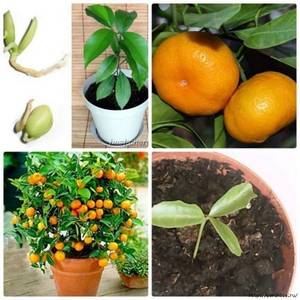
Mandarin, like other citrus fruits, reproduces by seed and vegetative methods.
Citrus seeds are typically obtained from fruits purchased at grocery stores. But the fruits of seedless hybrids often appear on the shelves. This makes it difficult to obtain planting material.
Most gardeners propagate tangerines vegetatively. Obtaining air layering is a labor-intensive process that is only possible if there is an adult tree suitable for this procedure.
You can get a cutting from a plant that bears fruit. However, rooting a tangerine is difficult. Often, the seedling does not form roots, but experienced gardeners say that successful plantings do occur.
The most common method of propagating tangerines is graft cuttings to the lemon or orange rootstock. We are not talking about a lemon tree that will have only one branch with orange fruits. In this case, the trunk of the mother plant is used, onto which a tangerine cutting is grafted. A plant grafted in this way becomes a full-fledged tangerine.
Rooting cuttings
Despite the fact that the rooting of a tangerine, even if planted correctly, has a low chance, many gardeners prefer to propagate the tree using this method. If all the rules are followed, there is a small chance that such a breeding method will be successful.
Note! Mandarin is rooted at a temperature of +24…+26°C.
Obtaining planting material
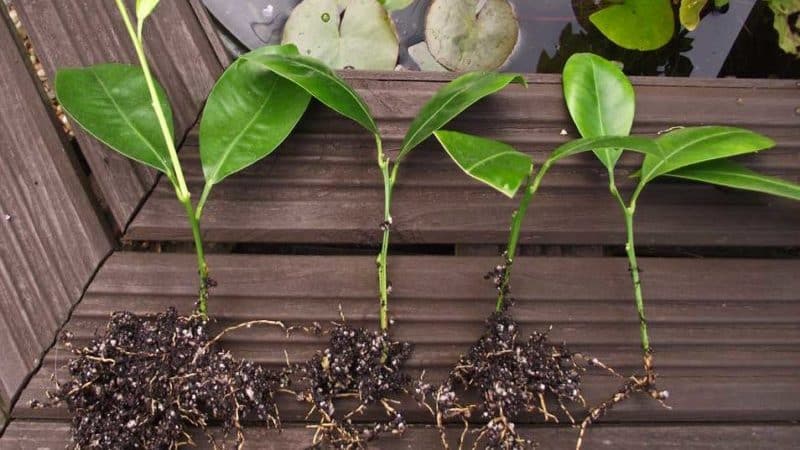
To grow a tangerine from a branch, it is important to choose suitable planting material. Ready-made tangerine seedlings are not sold in stores, but you can find cuttings for grafting on the shelves.
Suitable planting material has the following characteristics:
- dense, dark, elastic and not dry bark;
- length from 8 to 15 cm;
- the presence of 3 developed buds without peeling;
- no traces of disease.
To get a cutting yourself, you will need an adult tree that has already bear fruit. It must be healthy and free from disease.
Important! Before the procedure, the instrument that will be used to cut the stalk is disinfected: wiped with alcohol or calcined over a fire.
For tangerine cuttings, choose a branch 1 year old. 8-15 cm extend from its top. There should be at least 3 living buds on this segment. The shoot is cut at an angle of 45°. The cut site on the mother tree is treated with garden varnish.
Preparing the cuttings
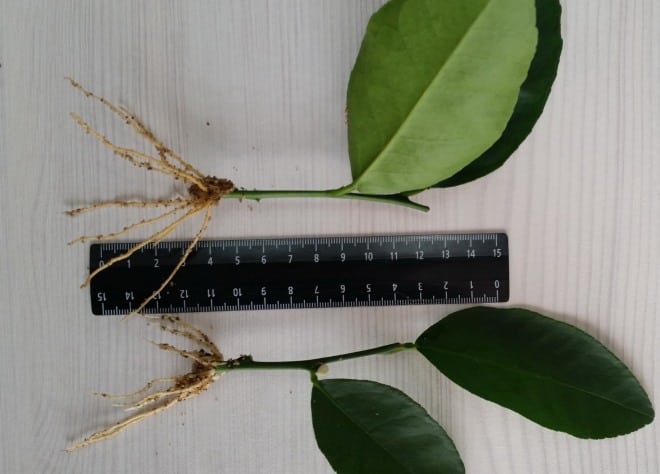
Before you start grow a houseplant, planting material is prepared. This process includes the following steps:
- All the lower leaves on the cuttings are cut off, leaving 2 to 4 on top. Small leaves are not touched, large ones are cut by half, and small ones by a third.
- A cut of a seedling is soaked for half an hour in a light pink solution of potassium permanganate.
- Stimulate the formation of roots by soaking the lower part of the branch in the Kornevin solution.
If the cutting is not planted immediately after pruning, the cut is renewed at the same angle.
Planting dates and technology
It is recommended to root the seedling in the spring (March or June), when sap flow is active.
To plant a seedling you will need a soil mixture. To prepare it, mix 1 part of sand, leaf soil and humus with 2 parts of garden soil. soil. The resulting mixture is disinfected in one of the following ways: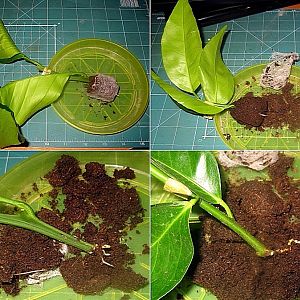
- watering with a dark pink solution of potassium permanganate;
- calcination for 30 minutes at a temperature of +100°C;
- watering with a solution prepared from 1 tbsp. l. copper sulfate and 1 bucket of water;
- pouring boiling water.
For 5 kg of the resulting mixture take 25 g of superphosphate, 0.5 tbsp. ash and 15 g of potash fertilizer. All ingredients are mixed.
To grow a tangerine tree from a twig at home, you will need drainage. It is disinfected using the same method as soil.
Plant the cuttings in a cut bottle, plastic cup or special pot. There should be drainage holes at the bottom of the container. Containers are disinfected by soaking in boiling water or a dark pink solution of potassium permanganate.
How to plant a tangerine cutting: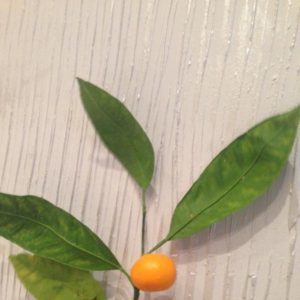
- A layer of drainage is placed at the bottom of the container. The rest of the volume is filled with earth. The soil is moistened with warm water.
- The cuttings are planted in the ground with the cut down. The depth should be such that the seedling can stand without support.
- The soil is moistened abundantly with warm water.The seedling is covered with the cut off upper part of the bottle if it is planted in the lower part of the bottle, or with a film or bag in other cases. This will create a humid tropical microclimate that is optimal for rooting.
Before rooting, the tangerine should be in such a greenhouse. During this time, the seedling is watered and sprayed with wet water daily. The film is removed every day for 15-30 minutes.
The fact that the seedling has taken root will be indicated by swelling and opening buds. Mandarin is replanted no earlier than a month after rooting.
When the tangerine takes root, the duration of ventilation is increased. After some time, the film is removed.
How to increase the chances of rooting
Will a tangerine sprig give roots? In most cases, the cutting does not take root, but dries out. We offer advice from gardeners whose tangerine seedlings have taken root:
- Hybrid tangerines take root better than varietal ones.
- To create a comfortable temperature, place an electric heating pad under the pot with the cutting.
- In order for the cuttings to take root better, the mother tree is not watered before cutting the planting material. It is advisable to dry an adult tangerine for several days. Cuttings cut from a watered plant most often rot.
Grafting a cutting
The most successful way of vegetative propagation of tangerine is to graft a cutting onto a lemon or orange rootstock. In this case, the chances that the planting material will take root are high.
It is best to graft a tangerine onto a lemon grown from a seed. This plant is characterized by increased endurance and resistance to negative environmental factors.
Note! Mandarin takes root more slowly than other citrus plants.This process takes up to 2 months.
Preparation of scion and rootstock
An orange or lemon is used as a rootstock. The tree must be at least a year old. Plants that are too mature (over 2 years old) are not suitable for this procedure. They have a separate branch as a rootstock.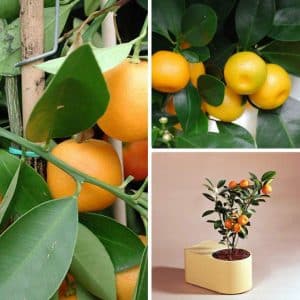
The rootstock is watered and feed 3 days before the procedure. 2 months before grafting, the plant is transplanted into a new pot with nutritious soil mixture.
For the scion, they choose last year's branch on a tree that has already bear fruit. It should not show signs of disease or damage. The bark is dense, but not dry.
5-8 cm retreat from the top of the branch. 2-3 living branches should remain on this segment. The required part is cut at an angle of 45°. The cut on the mother plant is smeared with garden varnish.
Tangerine is grafted in March or April. During this period, active sap flow is observed, increasing the chances that the cutting will take root.
Vaccination procedure
The easiest way is to graft the cutting into a cleft. This method is called copulation.
Step-by-step instructions for grafting a tangerine cutting:
- Rootstock (young lemon grown from seed) trimmed by 1/3. Only the trunk without leaves and buds should remain. The cut is made at an angle of 45°.
- A cut is made in the center of the rootstock from top to bottom (split) 1.5-2 cm deep. The cut is made carefully, with a sharp knife, so that the rootstock does not crack.
- All leaves are removed from the scion, leaving the buds. From the cut side, the cutting is ground on both sides at an angle. You should get a thin wedge that matches the length of the split in the scion.
- The scion wedge is inserted into the split on the rootstock to the maximum depth. The sides of the rootstock are widened with a thin blade to push the cutting deeper.
- The junction of the scion and the rootstock is tightly wrapped with a special garden tape or electrical tape. There should be no open areas. It is important not to overtighten the trunk so as not to disrupt sap flow.
- The tree is watered and sprayed abundantly. Place damp cotton wool at the bottom of the pot, which is moistened as needed.
- The grafted tangerine is covered with a bag and put in a place protected from direct sunlight.
The fact that the cuttings have taken root will be indicated by swelling of the buds and the appearance of shoot primordia. After this, the film is removed and the tangerine is moved to the windowsill.
Basic rules of care
Once the tangerine has taken root, it is important to provide it with proper care. Otherwise, the plant will get sick and will not survive the winter.
Temperature
After the tangerine takes root, the temperature in the room where it grows is maintained within +16...+20°C. When the tree blooms, the temperature is increased to +25°C. In winter, choose a room with indicators of +10...+12°C.
Lighting
In the warm season, tangerines are placed on the eastern or western windowsill. In winter, it is recommended to move the plant to a south window.
Humidity
Mandarin is sprayed daily with warm, settled water. In winter, if the plant is near a battery, place a humidifier or a container of water nearby.
Watering
In summer, water the tangerine as the top layer of soil dries out (every day). In winter, one watering per week is sufficient. Use warm, settled water.
Feeding
Tangerines are fed twice a week from spring to autumn. Alternate mineral and organic fertilizers. Special mixtures for citrus fruits or folk remedies are used as fertilizers.Popular homemade supplements include tea and coffee, chicken manure diluted 1:10 with water, infusion of vegetable peelings, fish broth, and ash infusion.
Bloom
During the first flowering, all inflorescences are removed. Otherwise, the plant will spend all its energy on them and die. Then the buds are not picked. This tree does not require artificial pollination.
Fruiting
During the first fruiting period, 2-3 ovaries are left on the tree. The next year the tangerines are not picked.
Cleaning from dust
Once a week, tangerine leaves are wiped with a damp cloth to remove dust. Every month the plant is washed in the shower with warm water.
Transfer
Before the first fruiting, the tangerine is replanted once a year. It is transferred into a pot along with a lump of earth. Each new container should be 5 cm larger than the previous one. The free space is filled with soil (the same as for rooting the cutting). Add 1 part more garden soil to the soil mixture.
Plants that bear fruit are replanted once every 2-3 years. When transplanting, the roots are cleared of soil and old shoots are removed.
Formation
Formation is necessary for the tangerine to bear fruit and have a neat appearance. This procedure also reduces the risk of plant infection.
There are two types of pruning – formative and sanitary. Sanitation involves the annual removal of dry, broken and diseased branches.
Formation is carried out as follows:
- When the plant reaches a height of 40-60 cm, its top is pinched. This is necessary to form first-order branches and limit growth in height.
- First order branches are pruned after 4-5 leaves. It is recommended to leave no more than 3-4 branches of the same order, directed in different directions.
- Proceed in the same way with branches of 2nd, 3rd and 4th order.This stimulates the growth of shoots of the next order.
The cutting areas are covered with garden varnish to reduce the risk of plant disease.
Reference. Mandarin fruits appear on branches of the 4th and 5th order.
Conclusion
Rooting a tangerine cutting rarely ends in success. The shoots of this plant rarely produce roots. And even if the cutting does take root, there is no guarantee that it will survive the winter.
It is recommended not to root tangerine cuttings at home, but to graft them onto the rootstock of another citrus fruit grown from a seed. Despite the fact that tangerine takes root slowly with other trees, the chances of successful reproduction in this case are greater.